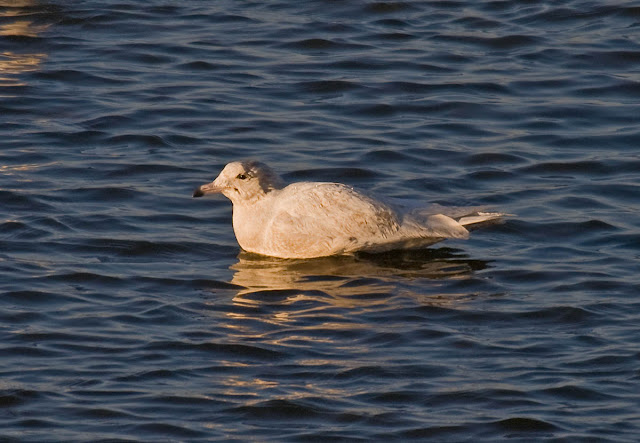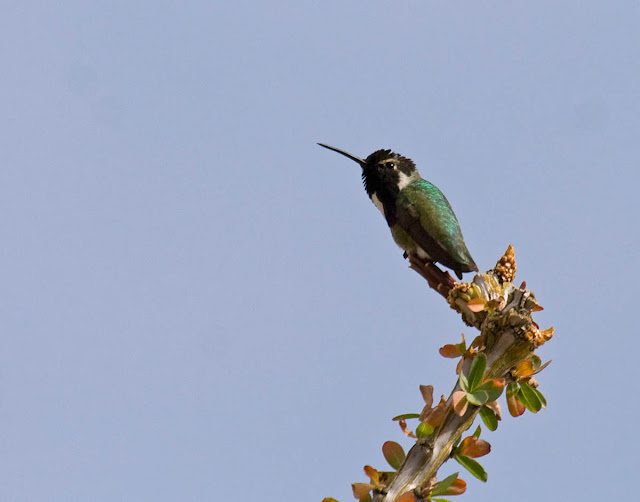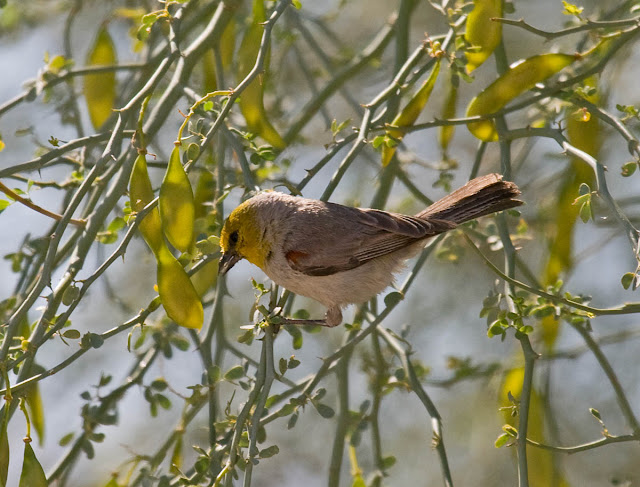My hope is that visiting birders might use this post to plan your own full day of birding here.
A) My route starts in Oceanside at San Luis Rey River mouth (site guide) and adjacent beach and marina.
2014: 6:45 AM, 1 hour and 4 minutes: This turned out to be a great stop for me. I picked up 39 species including a Little Blue Heron, some Black-vented Shearwaters flying by offshore, a Parasitic Jaeger harassing terns, a wintering Wilson's Warbler, and a White-throated Sparrow. There were even several Mew Gulls and a rare Glaucous Gull that had been discovered by others earlier. eBird checklist here.
 |
| Mew Gull |
 |
| Glaucous Gull |
B) Next I drive 17 miles to San Elijo Lagoon (site guide).
2014, 8:11 AM, 2 hours and 34 minutes: I covered only the Rios Road side of the Lagoon. The 57 species was good, including an Allen's Hummingbird and a couple Ridgway's Rails. But the rare Nelson's Sparrow I discovered was a great find--and stayed all winter for others to see during highest tides. So, I ended up staying here longer than planned. eBird checklist and photos here.
2014, 10:48 AM, 55 minutes: I also walked eastward along the south edge of the lagoon, but the 28 species included nothing noteworthy, except more Allen's Hummingbirds. eBird checklist here.
 |
| Nelson's Sparrow |
2016, 9:35 AM, 1 hour and 12 minutes: At the Rios Road entrance I birded only down the pole trail. A single Ridgway's Rail and Anna's Hummingbird this year highlighted the 35 species. eBird checklist here.
 |
| Snowy Egret |
2014, 12:33 PM, 45 minutes: Because I had dallied at San Elijo Lagoon I was running out of time. So, rather than a 3 mile hike on the East side of the lake, I decided to bird the Del Dios area on the west side of Lake Hodges. I don't often go there. I just watched birds from the shoreline below the parking lot. The 24 species were typical and didn't include anything of note. eBird checklist here.
2016, 11:58 AM, 2 hours and 14 minutes: This time I hiked the 3 mile loop around the Rancho Bernardo arm of the lake. This provided 55 species, including American White-Pelican, Sora, Roadrunner, White-throated Swift, an early Northern Rough-winged Swallow, and 4 Violet-green Swallows. Eight California Gnatcatchers were also good. eBird checklist here.
D) Now, I drove Highland Valley Road to the Ramona Grasslands Preserve (site guide). It's only 12 miles, but takes more than 20 minutes on winding hilly rural roads.
2014, 1:58 PM, 1 hour and 2 minutes: Because I skipped hiking around Lake Hodges, I hiked 2 miles around the Wildflower Loop at the Ramona Grasslands Preserve. Notable birds included a Sharp-shinned Hawk and 9 Mountain Bluebirds. eBird checklist here.
2014, 3:05 PM, 40 minutes: Around the corner I drove the 1 mile of Rangeland Road. There were 2 Ferruginous Hawks and 65 more Mountain Bluebirds. eBird checklist here.
 |
| Mountain Bluebird |
2016, 2:51 PM, 48 minutes: Rangeland Road provided a couple Snow Goose and Cackling Goose among the 800 Canada Goose. A Bald Eagle joined the 2 Ferruginous Hawks on my list. There were 19 Mountain Bluebirds this year. eBird checklist here.
 |
| Prairie Falcon |
 |
| Snow Goose among Canada Goose |
 |
| Ferruginous Hawk |
2014, 4:13 PM, 19 minutes: Good birds included 4 fly-by Cattle Egrets over the dairy farmland, and the target bird--3 Cactus Wrens. The day is over at 4:32 PM. eBird checklist here.
 |
| Cactus Wren |
 |
| Peregrine Falcon |















